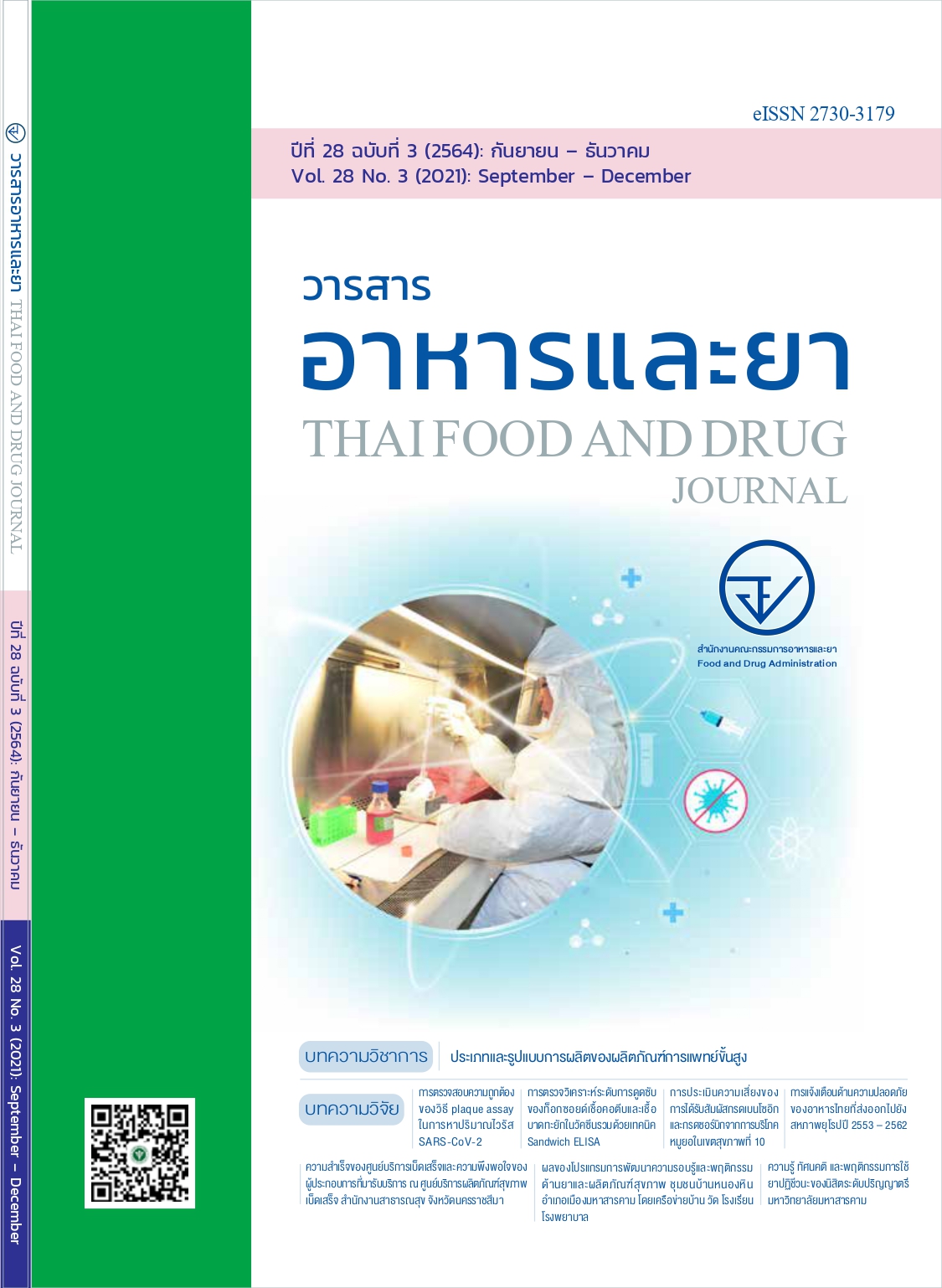การตรวจสอบความถูกต้องของวิธี Plaque Assay ในการหาปริมาณไวรัส SARS-CoV-2
Main Article Content
บทคัดย่อ
ความสำคัญ: จากการแพร่ระบาดของไวรัส SARS-CoV-2 ทั่วโลก จึงมีการวิจัยพัฒนาวัคซีนป้องกันโรคขึ้นเพื่อกระตุ้นระบบภูมิคุ้มกันต่อเชื้อดังกล่าว ซึ่งจำเป็นต้องใช้ไวรัสในการทดสอบ ดังนั้นการหาปริมาณไวรัสจึงเป็นสิ่งจำเป็น โดยที่ plaque assay ถูกนำมาใช้ใการหาปริมาณไวรัส SARS-CoV-2 ซึ่งเป็นวิธีการเชิงปริมาณในการวัดการติดเชื้อ SARS-CoV-2 โดยการหาปริมาณของ plaques ที่ก่อตัวขึ้นในเซลล์เพาะเลี้ยง โดยทำการเจือจางไวรัสที่ระดับความเจือจางต่าง ๆ plaque forming unit (PFU) คือ กลุ่มเซลล์ที่ถูกไวรัส 1 อนุภาคทำลาย
วัตถุประสงค์: เพื่อศึกษาการตรวจสอบความถูกต้องของวิธี plaque assay โดยทำการหาปริมาณไวรัสจาก clinical specimen จากผู้ป่วยที่ติดเชื้อไวรัสโควิด 19 สายพันธุ์ hCoV-19/Thailand_59/2020
วิธีการวิจัย: เพิ่มจำนวน SARS-CoV-2 ในเซลล์เพาะเลี้ยงเพื่อให้ได้ปริมาณไวรัสที่เพิ่มขึ้น และทำการ aliquot จำนวน 700 cryo tubes จากนั้นทำการสุ่มเพื่อนำมาศึกษาจำนวน 60 cryo tubes โดยวิธี plaque assay พร้อมตรวจสอบความถูกต้องของวิธีในพารามิเตอร์ได้แก่ การตรวจสอบความแม่น ความเที่ยง ทั้งแบบ repeatability และ reproducibility ความคงทน และความจำเพาะของวิธี ระยะเวลาศึกษา มิถุนายน 2563 - มิถุนายน 2564
ผลการศึกษา: พารามิเตอร์ความแม่นพบว่าค่าความแตกต่างของปริมาณไวรัสสูงสุดและต่ำสุดไม่เกิน 0.5 logPFU แสดงให้เห็นว่าวิธีมีความแม่น มีความเที่ยงทั้งแบบ repeatability ได้ค่า geometric mean (GM) เท่ากับ 5.76 logPFU standard deviation (SD) เท่ากับ 0.05 ค่า 95% confidence interval (95%CI) เท่ากับ 5.65-5.87 logPFU ค่า%CV เท่ากับ 0.94 และการศึกษา reproducibility ได้ค่า GM เท่ากับ 5.76 SD เท่ากับ 0.18 95%CI เท่ากับ 5.40-6.12 logPFU %CV เท่ากับ 3.12 วิธีมีความคงทน โดยได้ค่า GM เท่ากับ 5.74 logPFU SD เท่ากับ 0.19 95%CI เท่ากับ 5.35-6.13 logPFU ค่า%CV เท่ากับ 3.38 และในการศึกษาความจำเพาะ ได้ค่า Sig (2-tailed) เท่ากับ 0.038 ซึ่งน้อยกว่า 0.05 แสดงให้เห็นว่าปริมาณไวรัสที่ได้จาก negative serum ผสมกับ SARS-CoV-2 มีมากกว่าใน positive serum ผสมกับ SARS-CoV-2 อย่างมีนัยสำคัญทางสถิติ บ่งบอกได้ว่าวิธีมีความจำเพาะที่ดี
สรุป: จากข้อมูลข้างต้นจึงสรุปได้ว่าสามารถนำวิธี plaque assay มาใช้เป็นวิธีมาตรฐานในการตรวจหาปริมาณไวรัส SARS-CoV-2 ซึ่งจะเป็นประโยชน์ต่อการนำวิธีนี้มาปรับใช้กับการตรวจ neutralizing antibody ในคนไข้โควิด-19 รวมทั้งในสัตว์และคนที่ได้รับวัคซีนโควิด-19 ใน biosafety level 3
Article Details

อนุญาตภายใต้เงื่อนไข Creative Commons Attribution-NonCommercial-NoDerivatives 4.0 International License.
เอกสารอ้างอิง
World Health Organization. WHO announces COVID-19 outbreak a pandemic [Internet]. Geneva: WHO; 2020 [cited 2020 Nov 18]. Available from: http://www.euro.who.int/en/health-topics/health-emergencies/coronavirus-covid-19/news/news/2020/3/who-announces-covid-19-outbreak-a-pandemic
World Health Organization. Draft landscape of COVID-19 candidate vaccines [Internet]. Geneva: WHO; 2020 [cited 2020 Dec 20]. Available from: https://www.who.int/publications/m/item/draft-landscape-of-covid-19-candidate-vaccines
Fukuda A, Sengun F, Sarpay HE, Konobe T, Saito S, Umino Y et al. Parameters for plaque formation in the potency assay of Japanese measles vaccines. J Virol Methods 1996;61: 1-6.
World Health Organization. Requirements for varicella vaccine (live), technical Report Annex 1 [Internet]. Geneva: WHO; 1994 [cited 2020 Dec 22]. Available from:https://www.who.int/publications/m/item/varicella-vaccine-(live)-annex-1-trs-no-848
Husson Van Vliet J. Colinet G, Yane F, Lemoine P. A simplified plaque assay for varicella vaccine. J Virol Methods 1987;18(2-3):113-20.
World Health Organization.Recommendation for Japanese encephalitis vaccine (inactivated) for human use (revised 2007). [Internet]. Geneva: WHO; 2020 [cited 2020 Dec 29]. Available from: https://www.who.int/biologicals/vaccines/Annex_1_WHO_TRS_963.pdf?ua=1
World Health Organization.Guidelines for the production and control of Japanese Encephalitis vaccine (live) for human use. Technical Report Series No. 910. 2002; Annex 3 [Internet]. Geneva: WHO; 2020 [cited 2020 Dec 29]. Available from: https://www.who.int/biologicals/areas/vaccines/jap_encephalitis/WHO_TRS_910_A3.pdf
Forcic D, Kosutic-Gulija T, Santak M, Jug R, Ivancic-Jelecki J, Markusic M, et al. Comparisons of mumps virus potency estimates obtained by 50% cell culture infective dose assay and plaque assay. Vaccine 2010;28(7):1887-92.
World Health Organization. Requirements for measles, mumps and rubella vaccines and combined vaccines (live) [Internet]. Geneva: WHO; 1994 [cited 2020 Dec 29]. Available from: http://apps.who.int/iris/bitstream/handle/10665/39048/WHO_TRS_840_(part2).pdf;jsessionid=DEAC76A6984EEDF96AB7E2DB2BA54114?sequence=2
World Health Organization. Requirements for poliomyelitis vaccine (Oral) [Internet]. Geneva: WHO; 1990 [cited 2020 Dec 29]. Available from: http://apps.who.int/iris/bitstream/handle/10665/39526/WHO_TRS_800_(part1).pdf?sequence=1
World Health Organization. Manual of laboratory methods for testing of vaccines used in the WHO expanded programme on immunization [Internet]. Geneva: WHO; 1997 [cited 2020 Dec 30]. Available from: https://apps.who.int/iris/handle/10665/63576
Wang J, Feng H, Zhang S, Ni Z, Ni L, Chen Y, et al. SARS-CoV-2 RNA detection of hospital isolation wards hygiene monitoring during the Coronavirus Disease 2019 outbreak in a Chinese hospital. International Journal of Infectious Diseases 2020;94:103-106.
การตรวจสอบความแรงและความคงตัวของวัคซีนป้องกันโรคไข้สมองอักเสบเจอีชนิดเชื้อเป็นลูกผสมโดยเซลล์เพาะเลี้ยง Vero. นนทบุรี: สถาบันชีววัตถุ กรมวิทยาศาสตร์การแพทย์; 2018. หน้า 11.
กรมวิทยาศาสตร์การแพทย์, สถาบันชีววัตถุ. การตรวจสอบความถูกต้องทางชีววิธี (Bioassay Validation). นนทบุรี: สถาบันชีววัตถุ กรมวิทยาศาสตร์การแพทย์; 2020. หน้า 1-8.
Darling A, Boose J, Spaltro J. Virus Assay Methods: Accuracy and Validation. Biologicals 1998;26(2):105-110.
Thomas S, Jarman R, Endy T, Kalayanarooj S, Vaughn D, Nisalak A et al. Dengue Plaque Reduction Neutralization Test (PRNT) in Primary and Secondary Dengue Virus Infections: How Alterations in Assay Conditions Impact Performance.The American Journal of Tropical Medicine and Hygiene 2009;81(5):825-833.
Freshey RI. Culture of animal cells: a manual of basic technology (4th ed), Wiley-Liss 1994;290-96.
Low IE. Mycoplasma in tissue culture: Overview of detection methods. Health Lab Sci 1976;13:129-36.
Chen TR. In situ detection of mycoplasma contamination in cell cultures by fluorescent Hoechst 33258 stain. Exp. Cell.Res 1997;104:255-62.
สุกัลยาณี ไชยมี, สุภาพร ภูมิอมร. การประเมินความถูกต้องของวิธีปฏิกิริยาลูกโซ่โพลีเมอเรสในการตรวจหาการปนเปื้อนเชื้อมัยโคพลาสมาในเซลล์เพาะเลี้ยง. วารสารกรมวิทยาศาสตร์การแพทย์ 2551;50(2):87-102.
Phumiamorn S, Kullabutr K, Tepbhuthorn S, Jivapaisarnpong T. Detection of mycoplasma contamination in cell culture: comparison between DNA fluorochom staining and PCR amplification methods. Thai J. Pharm Sci 2006;30:82-92.


